DIY Interior Painting: Professional Tips for a Flawless Finish
Preparation is Key
Achieving a flawless finish in your DIY interior painting project starts long before the first brush stroke. Begin by gathering all necessary supplies. You'll need top-quality paint, brushes, rollers, painter's tape, drop cloths, and a paint tray. Don't forget to wear old clothes or coveralls to protect yourself from splatters.
Next, prepare the room by removing or covering furniture and other items. Use drop cloths to protect floors and tape off areas you don’t want painted, such as trim or windows. Thorough surface preparation ensures a smooth finish, so take time to clean walls and repair any holes or cracks.

Selecting the Right Paint
Choosing the right paint can make all the difference in your project. Consider the room’s purpose and lighting when selecting colors. For instance, lighter shades can make a small room feel more spacious, while bold colors add character to larger areas.
There are different types of paints to choose from, including latex and oil-based varieties. Latex paint is popular for its ease of use and quick drying time, whereas oil-based paints offer durability in high-traffic areas. Be sure to select the appropriate finish—matte, eggshell, satin, or gloss—based on your desired look and maintenance needs.

Mastering the Technique
Once your space is prepped and you've selected your paint, it's time to dive into the actual painting process. Start by cutting in around the edges of the walls using a brush. This involves painting a border around ceilings, corners, and trim before filling in the larger areas with a roller.
When using a roller, apply paint in a “W” or “M” pattern to ensure even coverage. Work in small sections and maintain a wet edge to avoid lap marks. Take your time with each stroke; rushing can lead to an uneven finish. Remember to apply multiple thin coats rather than one thick coat for the best results.
Finishing Touches for Perfection
After your final coat has dried, carefully remove painter's tape while the paint is still slightly damp to avoid peeling off any fresh paint. Inspect your work for any missed spots or imperfections and touch up as needed.
Once everything is dry and satisfactory, clean your brushes and rollers for future use. This step not only saves money but also ensures you’re ready for any touch-ups or future projects.

Common Mistakes to Avoid
Even with careful preparation and execution, mistakes can happen. Avoid common pitfalls such as skipping primer on previously unpainted surfaces, which can lead to uneven absorption and blotchy finishes. Also, resist the temptation to over-saturate your brush or roller with paint—this often results in drips and streaks.
Another frequent error is painting over dust or debris. Always ensure surfaces are clean before starting to avoid ruining that perfect finish. With these tips in mind, you’re well on your way to achieving a professional-looking paint job.
Conclusion
Tackling a DIY interior painting project can be rewarding and transform any space into something new and vibrant. By following these professional tips—from preparation to execution—you’ll achieve a flawless finish that you can proudly show off. Remember, patience and attention to detail are your best allies in this journey.